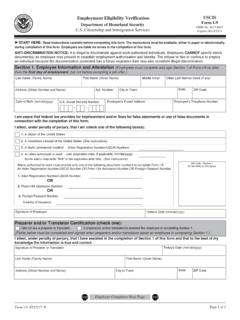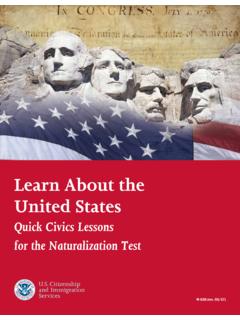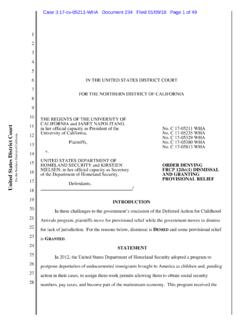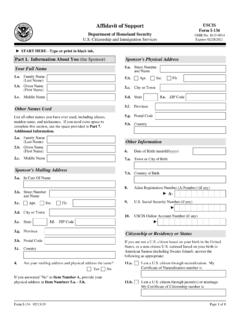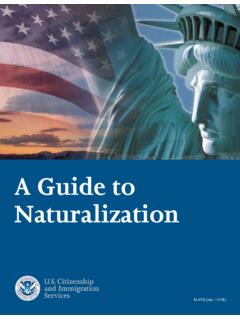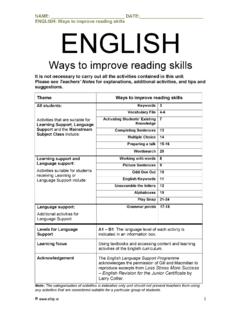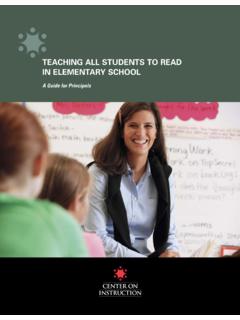Transcription of Basic Strategies for Teaching Reading Skills for the ...
1 TIP CITIZENSHIP AND IMMIGRATION SERVICES1 Basic Strategies for Teaching Reading Skills for the Naturalization Interview and TestReading Skills are an integral part of the naturalization process. Most permanent residents, unless they qualify for an exception or accommodation, must demonstrate an ability to read in English to qualify for naturalization. Applicants for naturalization use Reading Skills to understand relevant USCIS forms, such as Form N-400, Application for Naturalization; to read and study the 100 Civics Questions and Answers; to read and study the Reading and writing vocabulary in preparation for the English test; and to read directional and security signs at USCIS offices. This document provides teachers with Strategies for Teaching Reading Skills in the adult citizenship education classroom. Determine Students Reading Proficiency and Build Upon It Assess students English Reading proficiency to determine their functioning level ( , beginning, intermediate, or advanced).
2 Ensure that the assessment measures the students proficiency for each of the four components of Reading vocabulary, alphabetics, fluency, and comprehension. Use the assessment results to place students at the correct class level or to refer students with lower levels of English Reading proficiency to an English as a second language program. Use native language Reading assessments to determine the student s native language Reading proficiency. Ask the student during the intake process how many years he or she attended school. Understanding students native language literacy Skills in collaboration with their English Reading proficiency helps individualize Reading activities in areas where students may need more Materials that Reinforce Citizenship Content Select and use adult citizenship textbooks and materials that support learning.
3 Find and adapt materials accordingly. Reinforce materials with oral language. Ensure that classroom materials are at the appropriate level. Use manageable length Reading passages. Use color (different colored markers or colored-paper) to highlight key civics concepts, new vocabulary, or letter and sound patterns. Use flash cards, such as the Civics Flash Cards for the Naturalization Test and Reading and Writing Vocabulary Flash Cards, in various ways and have students study them frequently. Write down new naturalization and civics-related vocabulary on index cards and place them on walls to build word walls and display them by topic throughout the classroom. Encourage students to use bilingual dictionaries. Use visuals such as maps, photos, videos, and realia or objects or activities used to facilitate classroom discussion such as historical documents, globes, signs, and classroom props to provide Various Learning Activities Identify, define, and pre-teach new vocabulary and grammar that students will encounter in the citizenship textbook, naturalization preparation materials, and USCIS forms, especially Form N-400, Application for Naturalization, as well as other Reading materials.
4 Limit the amount of new vocabulary and grammar to prevent overwhelming students. Teach students to perceive different types of sounds in letters and words ( , soft and hard vowel sounds). This is a good activity to help students learn the names of people and places, such as Benjamin Franklin and Philadelphia. Integrate activities that use letter and word recognition. Focus on Teaching the most common (or high frequency) words first. High frequency words appear throughout Form N-400, Application for Naturalization as well as in the naturalization test. Some examples include the words: is, are, before, after, in, and on. Conduct content word recognition activities. Include activities that require students to fill in the missing word from a sentence or paragraph. This type of activity is referred to as a CLOZE activity.
5 You can find these and other types of classroom exercises on the USCIS Citizenship Resource Center under Lesson Plans and Activities. Teach students the Basic parts of speech. Have students put the USCIS Reading vocabulary words into sentences and have them read the sentences both silently and aloud to themselves. Help students adapt their pronunciation, intonation, and fluency. Model correct pronunciation and fluency. Focus on comprehension during silent Reading activities by developing questions related to the civics content. Ask students questions about what they read after they complete the Reading passage. Use the Lesson Plans and Activities, whichcontain civics-related material and additional Reading activities, to help students prepare for the naturalization interview and find additional citizenship education materials and instructional resources, visit the USCIS Citizenship Resource Center at

